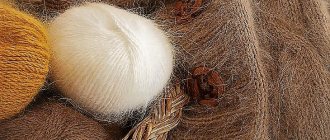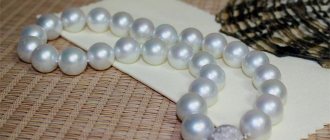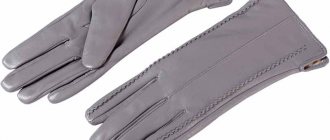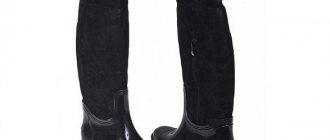Viscose: fabric properties
Manufacturers are attracted by the wide possibilities of using viscose fiber. By changing the type and thickness of fiber when making fabric, you can achieve almost complete similarity with such popular natural materials as linen, cotton, wool, and silk. By adding natural fibers to viscose fabric, you can significantly improve the properties of viscose fabric and, accordingly, products made from it.
Unlike natural fabrics, when producing viscose, dyes are added during the manufacturing process, which allows you to achieve bright, rich colors of viscose fabric. Viscose, in addition to the above, can also be a raw material basis for the production of cellophane, carpets, car tires, household sponges, artificial leather, mattress fillings, etc.
If the clothes are stretched
When mixing viscose fibers with wool and cotton, the products, on the contrary, stretch after washing. The following techniques will help you reduce the size, which should be chosen taking into account the exact composition of the fabric.
- Combination of viscose and cotton
Cotton is not susceptible to warping, but sometimes it still happens. Washing in hotter water than indicated on the tag, with a spin cycle at medium speed, will help restore the shape. At the end, the products are immersed in hot water with air conditioning for 10 minutes. Dry using a dryer, or spread out on a warm surface.
- With synthetic additives
Clothes are washed with high water heat and spun at maximum speed. Then they are immersed in ice water for a couple of hours. At the end of soaking, carefully squeeze and dry.
- With an admixture of wool fibers
Wool threads are highly susceptible to stretching. To reduce an item by a couple of sizes, it is washed at t = 50-60°. The spin is set to the pointer position above 500 rpm. After removing from the machine, wash with cold water and dry flat on a warm, horizontal surface.
Features of viscose
Viscose fabric is comfortable and pleasant to wear, breathes well and absorbs moisture. Due to its natural origin, it does not accumulate electrical charge and does not cause allergies. High moisture-absorbing and hygienic properties make it possible to use viscose fabrics in sewing children's clothing.
When sewing women's clothing, beautiful soft folds are formed on the product. It has a silky sheen, as the viscose thread turns transparent and shiny during the production process. If it is necessary to obtain a more muted shade of fabric color, additives are added to the solution to obtain a matte effect.
Viscose fabrics wrinkle easily, which makes them not very comfortable to wear. They have learned to compensate for this feature of viscose by adding a small percentage of elastane to the fabric composition. Thus, it was possible to obtain a new, more improved viscose material that does not cause such appearance problems to its owner. In addition, viscose is very vulnerable to the effects of negative atmospheric factors such as water, ultraviolet rays and others.
Rules for drying viscose clothes
To prevent viscose from deteriorating, it must not only be washed according to the rules, but also dried. Here are a few simple recommendations that will help you do this correctly:
- Under no circumstances should you hang washed items on household heaters or hot radiators.
- Ideally, viscose fabric should be dried in a straightened state.
- If this is not possible, you should hang clean clothes on a wide wooden hanger and take them out to the balcony.
- When you need to dry a small item, such as a T-shirt or skirt, you can wrap it in a terry towel to remove excess moisture.
- To make washed items dry faster, you need to dry them outside or on the balcony. If this is not possible, then you will need to at least arrange intensive ventilation in the room by opening the windows.
Caring for viscose products
During the washing process, viscose fabric loses its strength under the influence of water. You need to care for viscose and wash it very carefully, by hand or on the delicate cycle of a washing machine. Since the fabric also shrinks, the temperature regime should also be gentle, no more than 30 degrees. Caring for viscose products should be as gentle as possible.
Viscose fabrics are very delicate, so they need to be washed separately from other stiffer fabrics so as not to damage them during the friction caused by the rotation of the drum. Under no circumstances should you twist or wring out items made from viscose fabrics. It’s better to lay it out to dry on some surface, straightening out all the folds and creases with your hands.
When ironing, you need to turn the clothes inside out. If you place the iron on the front side of the product, a shine will remain in this place, very different from the general appearance of the product. Ironing should only be done in the “silk” mode; at a higher temperature, the fibers may melt.
Considering the features and properties of viscose fabric, it is not at all difficult to learn how to properly care for viscose , thereby maintaining your favorite things in their original appearance.
Preparation before washing
If the item is not very dirty, there are no stains on it, then a regular rinse in cool water will help add freshness. You can soak for half an hour, then gently squeeze and dry. But this rarely happens; a full wash with previous preparation is often required.
What you need to do first:
- Sort things out. We remove white from color. Viscose may fade if low quality dyes are used.
- Turn out the pockets. Checking the seams. If there is a lot of debris or threads in them, you need to clean them with a brush.
- Fasten locks, buttons, snaps so that they do not deform the product when washed.
- If clothes have heavy brooches, buttons or other decorative elements, it is better to rip them off and unfasten them. Otherwise, wet viscose will stretch even more due to weight.
- Before washing, clothes should be turned inside out.
How to wash by hand at home
Before you start washing, you need to familiarize yourself with how to hand wash soiled clothes.
Water temperature
Before you start washing clothes, you need to familiarize yourself with the optimal temperature of the water. Experts do not recommend using too hot a liquid, since silk does not tolerate high temperatures. Therefore, the water must be heated to only 30-40 degrees. If you heat it up 10-20 degrees more, the material will begin to tear.
Choice of funds
There are several effective products that help remove stains from silk items.
Silk detergent
Previously, only laundry soap was used to hand wash silk clothes, but now special products are produced for working with such material.
It is necessary to use liquid detergent compositions instead of powders, which are only suitable for dense and coarse fabrics. Liquid gels dissolve better in water and do not act aggressively on silk material. At the same time, it is better to use products that are produced by the most well-known manufacturers.
Detergent gel for children's clothes
If you need to wash your child's clothes, you will have to use a gel for washing children's clothes. Such products contain components that will help clean silk from dirty stains. Effective compositions include:
- "Eared nanny." A universal gel used for washing items made from any fabric.
- Tortilla. Used for cleaning clothes made from colored fabric material.
Borax solution for white fabric
The most difficult thing to wash is white silk items, since not all detergents can clean them. Experts recommend using sodium tetraborate. Its advantages include the fact that it does not damage the fabric and cleans it of dirt and absorbed greasy stains. To prepare the solution, add a tablespoon of the substance to a liter container of water.
Washing process
To prevent silk from shrinking after washing, you need to familiarize yourself with the features of cleaning it from dirt.
To begin with, dirty things are soaked in warm water for 5-7 minutes, after which a detergent is added to it. In this case, the water temperature should not exceed 35 degrees. You need to wash things carefully so as not to spoil them. It is contraindicated to use force, as this can accidentally tear the fabric.
Rinsing
After finishing washing, they rinse the washed silk items. Some people think that they should be rinsed in cold water, but this is not true. Rinsing should be carried out in liquid heated to 25-30 degrees. Some people add 40-50 milliliters of vinegar or antistatic softener to a container of water while rinsing. This is done to better clean the fabric from any remaining dirt.
The silk must be squeezed out carefully so as not to accidentally tear it. Do not twist it by hand or squeeze it out with a centrifuge.
Instead, place the washed item on a flat surface and gently press it with your palm.
How to iron viscose
Natural viscose is a soft and lightweight fabric, somewhat similar to silk. It is great for summer dresses, but at the same time quite delicate. Viscose can be easily damaged or deformed if ironed incorrectly. Fortunately, ironing viscose is not so difficult if you know the basic rules that should be followed. Always iron viscose items from the inside out only, use the iron on a low setting and let the viscose cool before hanging or storing items to prevent wrinkles and maintain their beautiful appearance until the next wash.
We invite you to familiarize yourself with Decoding signs for clothing care
Preparing for washing
The special ribbed structure of corduroy and its hairiness give it the ability to collect and accumulate dust particles and small debris, so the fabric needs periodic cleaning.
The material also does not like water. After contact with her, he sits down and becomes deformed. Therefore, dry cleaning and maintenance should be preferred to wet cleaning.
Preparation begins with removing specks, lint, scraps of thread and hair from the trousers that have collected on the fabric. The thing is shaken several times. You can use a carpet beater. Then they are carefully treated with a lint brush or a roller made of sticky material. Heavy soiling and stains must be removed before washing. The affected area is soaked in warm soapy water from laundry soap shavings. You can dilute the powder with the addition of a stain remover for delicate fabrics. 20-30 minutes are enough for exposure. Then wash with detergent. To remove stains and heavy dirt, use ammonia. Re-soaking in clean water with the addition of 3-4 drops of ammonia per 5 liters will help restore attractiveness. cool liquid. The procedure lasts no more than 15 minutes. A fabric dye of a suitable shade will correct the situation with faded areas and stubborn stains.
When choosing, it is also important to consider the composition of the fabric. The procedure will have to be repeated periodically to refresh the paint.
During use, contamination cannot be avoided and things need to be refreshed periodically. So, how to wash corduroy trousers without sad consequences. There are two options.
Advantages and disadvantages
Viscose has many advantages compared, for example, with nylon, polyester, polyamide and acrylic:
- hypoallergenic, therefore used in children's clothing;
- allows air to pass through well - the skin in such things “breathes”;
- perfectly absorbs moisture from the body;
- does not require the use of an antistatic agent, since it does not collect static electricity;
- In summer, viscose clothing pleasantly cools the skin, and in winter it warms;
- easy to wash and dry quickly;
- Things do not fade or fade when worn.
Unfortunately, this wonderful material also has disadvantages:
- after washing, the fabric can greatly decrease in size, and the garment can become deformed;
- if the material does not contain additional additives, it is quite fragile;
- things made of viscose wrinkle a lot;
- over time, “pellets” form;
- This fabric requires special careful care.
Viscose jacket
How to machine wash
You shouldn’t deny yourself the pleasure of wearing viscose clothes if you don’t have the opportunity or desire to wash them by hand. A washing machine will successfully cope with this task; you just need to be properly prepared and know how to wash viscose in a washing machine.
- Items should be washed in the drum separately from items made from coarser fabrics.
- Load the clothes into the drum, placing them in the wash bag.
- Turn on the “Manual” or “Delicate” mode on the panel, set the temperature to 30°.
- Automatic spinning in a drum for viscose is contraindicated, so it must be turned off.
- Place liquid detergent or a capsule for washing delicate fabrics in the special compartment. They protect the fibers and reduce friction against the drum walls.
- If there is local contamination, you should add an oxygen stain remover, and for light-colored fabrics, chlorine-free bleach.
- When rinsing, it is recommended to use fabric softener.











